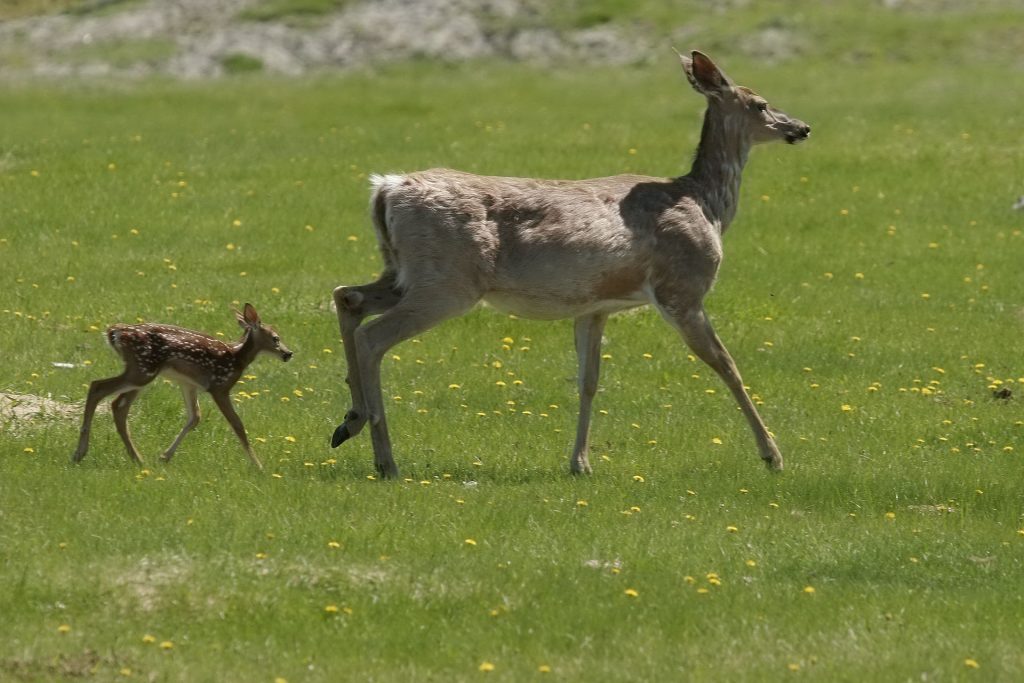 Cases of potentially fatal viruses are steadily rising in the Pacific Northwest as drought conditions worsen. Both bluetongue and epizootic hemorrhagic disease are spread through the bites of gnats known as “no-see-ums,” and are killing more PNW native animals — such as white-tailed deer — than in previous years.
Cases of potentially fatal viruses are steadily rising in the Pacific Northwest as drought conditions worsen. Both bluetongue and epizootic hemorrhagic disease are spread through the bites of gnats known as “no-see-ums,” and are killing more PNW native animals — such as white-tailed deer — than in previous years.
The gnats are more prevalent during the arid summer months, as they live in the deep layers of mud beneath water sources. When these sources dry up, the gnats are uncovered and can more easily access the animals. The Oregon Department of Fish and Wildlife told OPB that these gnats have been known to even live in water holes as small as a deer’s hoof print.
Kevin Snekvik of the Washington State University Washington Animal Disease Diagnostic Laboratory added that deer now gather in fewer areas for water due to limited supply, which makes the perfect breeding ground for the gnats.
“You have a bunch of animals that are close together,” Snevkik said, “and so the midges don’t have to go very far to find their next victim, per se.” Although he added that these viruses cannot be spread from deer to deer or to humans, Snevkik urges hunters to pass over deer who appear ill.
Snevkik’s lab tests deer for the viruses through samples, and he claims that white-tailed deer are at the greatest risk. Additionally, he commented that, while groups of deer can develop immunity over time, that immunity is not passed down to fawn — so the viruses can come back after they seemingly vanish.
“Your population starts having more and more animals that are susceptible to the virus because they don’t have immunity developed,” he said.
Climate change — particularly drought — plays another key role in the increasing outbreaks of the deadly viruses, according to Snevkik.
Washington state veterinarian Kristen Mansfield said that, although both viruses affect deer similarly, EHD almost never sickens animals other than white-tailed deer, while bluetongue can affect deer, bighorn, and domestic sheep. She added that on rare occasions EHD can affect domestic cattle, but is unlikely.
According to Snevkik, EHD is the more common of the two viruses this summer, with Oregon seeing a high uptick in cases. Collin Gillin, an ODFW state veterinarian, claimed that roughly 2,000 deer died of EHD in the Blue Mountains, forcing the Oregon department to terminate hunting season.
“There weren’t any deer there to have hunters go out and spend their time on, so EHD can hit a deer pretty hard,” said Gillin. “You just really have to keep an eye on it and try to track it. There’s nothing you can do about it.”
An outbreak in Kamiah and Clearwater, Idaho, also killed up to 300 white-tailed deer in August, according to Idaho Fish and Game. Central Oregon also reported an outbreak of black-tailed deer, which Gillin claimed was rare, as EHD most often sickens whitetails.
“We expect it. We’ve seen it more and more over the last 10 years, the more we’ve had drought conditions increase,” Gillin said. Snevkik added that this recent trend is concerning, and we will likely see more cases of both viruses because of climate change.
Mansfield commented that she sees the largest waves of the viruses August through October and typically sees a die-off after the first harsh cold eliminates the biting gnats.
“When I got the first report this summer, I looked at the calendar, and it was August 16,” Mansfield said, “My thought was, ‘Oh boy. Here we go. Right on schedule.’”
The viruses have struck deer populations in areas east of the Cascade Mountains, including Spokane Valley, Deer Park, Colfax, and Davenport.
The First Hunt workshop in the Kettle Falls area is held every August and teaches children the importance of conservation, as well as hunting skills. During the class, children noticed a deer that appeared to have contracted one of the viruses.
Additionally, one seasoned hunter and 14-year-old hunter-in-training, Ethan Hatzke, were hiking near a ridge when they came across a deer they believed had contracted bluetongue.
“We weren’t sure if it was bluetongue,” said Hatzke. “We saw a diseased deer. He wasn’t attacked or anything.”
The dry summer of 2015 was also a deadly season for deer of the Northwest. Wildlife biologist for the Washington Department of Fish and Wildlife, Annemarie Prince, said over 80 deer died within the city limits of Colville in northeastern Washington, among others.
Unfortunately, EHD and bluetongue are not the only zoonotic diseases spreading rampantly in our hotter climate. Cases of the West Nile Virus, which can sicken horses and even humans, have also increased, having been spotted in North Idaho just shy of the Canadian border, according to Snevkik.
“We’re seeing that over time, that viruses moves farther north, probably because the mosquitoes are carrying it farther because they know they can survive up there,” Snevkik said. He noted that mosquitoes carrying the WNV find the summer climate more hospitable.
By: Rebekah Harcrow
Do you have a story for The Advocate? Email editor@corvallisadvocate.com


